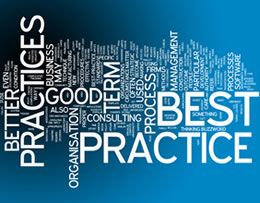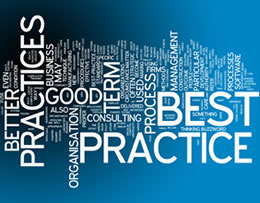
Leaving a Legacy of Lessons Learned
 “Those who cannot remember the past are condemned to repeat it”.
“Those who cannot remember the past are condemned to repeat it”.
– George Santayana
Project completion reviews or post-mortems are often seen as an essential best practice that enables organizations to learn from their experiences. However, all too frequently, the insights gained from post implementation reviews are lost to posterity.
There are a ton of books, periodicals and articles that address project management, software engineering and management of change disciplines and practices. But the rate of success for major business and technology changes is still well below 50%? Why? The bottom line – we lack a common mechanism where findings can be stored, examples cited and recommendations for future undertakings recorded and accessed. And, we lack the structure and discipline to ensure that our knowledge is managed and referenced consistently and rigorously.
According to Nancy Dixon in her conversation matters blog, “NASA learned its lesson about losing knowledge early in 1990. They experienced the sad recognition that much of the knowledge about how to build the Saturn V rocket that took the astronauts to the moon, had retired along with the engineers who had been encouraged to take early retirement”. In response, NASA created the NASA Engineering Network a knowledge network to promote learning and sharing among NASA’s engineers. The Network includes the NASA Lessons Learned data base, “the official, reviewed learned lessons from NASA program and projects”.
Most stakeholders involved in a change aren’t aware of all the best practice information out there and aren’t inclined to spend the time and money to find out. They’re business people, financial types, actuaries, engineers, marketing folks, business analysts, IT practitioners. They’re not project management or management of change experts. They don’t really understand the role they need to play and the information they need to ensure success! They just want to get the job done.
So, what do you do as a sponsor, stakeholder, PM, BA or other interested party to leave a legacy of lessons learned? There are five critical steps:
1. Identify and confirm accountability for managing lessons learned
Somebody needs to own this practice, to establish the goals and objectives, to measure performance, communicate to stakeholders and establish and drive initiatives to increase organizational value. Even open source software groups, which counts on thousands of interested volunteers to deliver and enhance functionality, have managing entities to oversee progress. Find an owner and hold him or her accountable. More on this later.
2. Build or acquire a framework
Even with lots of great experiences, insights and findings, without some kind of organizing structure, a collection of project post-mortems will pose an unwieldy and perhaps insurmountable barrier to leveraging collective lessons learned. Fortunately, PMI, ISO, ISACA, SEI and many other organizations have developed frameworks and a wealth of best practice information. I personally developed the Project Pre-Check Decision Frameworkto bring together the best of project management, management of change, software development and other practices and provide a Lessons Learned framework in my consulting practice. Select a structure you and your organization are familiar with and build it up with real world experiences and examples to facilitate effective use and enable real performance improvements. Or build your own framework.
3. Enforce usage
Having a comprehensive, easy to access, easy to use facility for mining best practices adds absolutely no value if no one uses it. So part of the Lessons Learned challenge, and a critical responsibility for the owner, is to ensure that everyone uses it, on every assignment, for every project. That use needs to involve a thorough review to identify and leverage applicable best practices and contributed learnings in a form and structure others can use. I can hear the groans already! More bullshit! More red tape! Get over it! If your organization wants to improve its ability to deliver major business and technology change successfully, a certain level of rigor and compliance is essential. What would you rather be, a sponsor, PM, BA or architect with an incredible track record of successful project deliveries, enabled by an organizational ability to leverage lessons learned, or an incredible individual contributor with a mixed record of project successes? Your choice!
4. Manage the transformation of project experiences to organizational Lessons Learned
A key challenge is gathering the experiences and insights of each project participant and the collective wisdom of project teams and abstracting that information into the selected framework. Don’t leave it up to the BA or PM to post the project learnings to the Lessons Learned framework! The owner needs to assume that responsibility and establish the analytical mechanisms and quality and usability standards that will ensure that others, in different circumstances and on other assignments, can quickly and effectively gain value from the information.
5. Manage Lessons Learned value contribution
There is no point in doing anything beyond individual project post-mortems if you’re not willing to manage the organizational value contribution. Getting a return from Lessons Learned means measuring usage, compliance, value derived and contribution frequency and identifying gaps and discrepancies in content and application. The measurement results provide the fodder to develop and implement continuing improvements to the practices, increasing the value delivered to the organization.
Where should Lessons Learned be managed? The PMO is an obvious suspect. The PMO mandate is usually very compatible with a Lessons Learned program. It typically has a broad view, encompassing enterprise or organizational initiatives, programs and projects. It should be tracking and reporting on aggregate project performance and taking steps to improve that performance, very compatible with a Lessons Learned program.
But, implementing a Lessons Learned practice across an organization is another change that has to be sold, prioritized, funded, initiated, staffed, managed and monitored. It is still very worthwhile but there is another option – the individual Lessons Learned practice. As a professional, you have undoubtedly committed yourself to a program of continuous improvement. An individual Lessons Learned practice starts and ends with you. You need to follow the same five steps reviewed above but you don’t have to sell anybody else on the idea. You are the decision maker. As you gain value, and confidence, you’ll build a track record and reputation others will notice. Also, share your experiences with your peers. Chances are you’ll find an enthusiastic audience and perhaps an attentive sponsor in waiting. Good luck.
Don’t forget to leave your comments below.
Drew Davison is a former IT practitioner, project manager and system development executive, the owner and principal consultant at Davison Consulting, a senior consultant at The Manta Group and the author of Project Pre-Check: The Stakeholder Practice for Successful Business and Technology Change. He works with organizations that are planning or undergoing major business and technology change to access the power of the Project Pre-Check building blocks; an effective stakeholder group, defined and proven processes and the decision framework, a mechanism for quickly leveraging industry best practices. Drew can be contacted directly at [email protected]